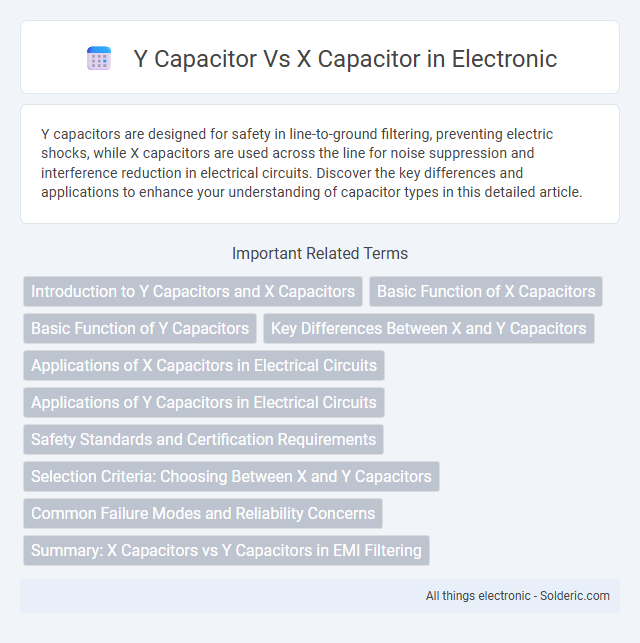Y capacitors are designed for safety in line-to-ground filtering, preventing electric shocks, while X capacitors are used across the line for noise suppression and interference reduction in electrical circuits. Discover the key differences and applications to enhance your understanding of capacitor types in this detailed article.
Comparison Table
| Feature | Y Capacitor | X Capacitor |
|---|---|---|
| Purpose | Line-to-ground noise suppression | Line-to-line noise suppression |
| Safety Standard | Class Y (UL 60384-14, IEC 60384-14) | Class X (UL 60384-14, IEC 60384-14) |
| Dielectric Type | High safety, flame-retardant dielectric | Robust dielectric for line-to-line stress |
| Voltage Rating | Up to 300VAC and above | Typically 250VAC to 400VAC |
| Failure Mode | Fails open to prevent shock hazard | Designed to fail short to avoid EMI |
| Application | Connected between line/neutral and ground | Connected across line and neutral |
| Typical Capacitance | 0.01 uF to 0.1 uF | 0.01 uF to 1 uF |
Introduction to Y Capacitors and X Capacitors
Y capacitors are safety-rated components designed to suppress electromagnetic interference (EMI) by connecting between the line and ground, ensuring user protection in appliances. X capacitors connect across the AC line, filtering differential mode noise and preventing voltage spikes from damaging equipment. Both types comply with strict safety standards, making them essential in EMI filtration and electrical noise reduction circuits.
Basic Function of X Capacitors
X capacitors are designed for EMI (electromagnetic interference) suppression in AC power lines, providing noise filtering by connecting across the live and neutral conductors. They protect your electronic devices by reducing differential mode interference, ensuring smoother power quality and safer operation. Unlike Y capacitors, which handle line-to-ground disturbances, X capacitors primarily manage line-to-line transient voltages.
Basic Function of Y Capacitors
Y capacitors are designed to connect between line and ground in electrical circuits, providing safety by filtering out high-frequency noise and preventing electrical shock. Their basic function is to suppress electromagnetic interference (EMI) while ensuring that leakage current remains within safe limits. Unlike X capacitors, which are placed across the line to reduce differential noise, Y capacitors specifically protect your devices from common-mode noise and enhance grounding safety.
Key Differences Between X and Y Capacitors
X capacitors are designed for across-the-line interference suppression and typically handle high voltage surges between line and neutral, whereas Y capacitors are intended for line-to-ground or line-to-chassis applications to enhance electrical safety. X capacitors usually have larger capacitance values and lower voltage ratings compared to Y capacitors, which require strict safety approvals and insulation robustness. The key difference lies in their placement and safety requirements: X capacitors connect across the power supply lines, while Y capacitors connect from line to earth for preventing electric shock.
Applications of X Capacitors in Electrical Circuits
X capacitors are primarily used across the line in electrical circuits to suppress differential mode interference by filtering noise between the live and neutral conductors. These capacitors are essential in power supply input stages, motor drives, and lighting ballasts to improve electromagnetic compatibility (EMC) and reduce conducted emissions. Designed to handle high-voltage surges, X capacitors ensure safety and reliability in alternating current (AC) power line applications.
Applications of Y Capacitors in Electrical Circuits
Y capacitors are primarily used in electrical circuits for safety applications, specifically in EMI (electromagnetic interference) suppression between line and ground. They are designed to handle high-voltage surges and prevent electric shock by maintaining isolation in power supply filters for appliances and equipment connected to the mains. Your devices rely on Y capacitors in power entry modules and noise filters to ensure compliance with international safety standards, enhancing the overall reliability and protection of electronic systems.
Safety Standards and Certification Requirements
Y capacitors and X capacitors serve distinct roles in electrical safety, with Y capacitors designed for line-to-ground applications meeting stringent safety standards such as IEC 60384-14 to prevent electric shock hazards. X capacitors, used across the line for EMI suppression, comply with standards like IEC 60384-14 and UL certification to withstand high voltage surges without posing fire risks. Your choice between Y and X capacitors must align with these certification requirements to ensure compliance and maintain safe, reliable circuit operation.
Selection Criteria: Choosing Between X and Y Capacitors
Selection between X and Y capacitors depends primarily on their intended application within an electrical circuit, with X capacitors designed for across-the-line interference suppression and Y capacitors for line-to-ground safety filtering. Key criteria include voltage rating, safety standards compliance such as IEC 60384-14 for X capacitors and IEC 60384-14/20 for Y capacitors, and their positioning relative to the mains input to ensure effective noise reduction without compromising user safety. The capacitance value, tolerance, and ability to withstand high transient voltages also play a critical role in selecting the appropriate capacitor type for reliable electromagnetic interference (EMI) mitigation and protection.
Common Failure Modes and Reliability Concerns
Y capacitors often fail due to insulation breakdown caused by voltage spikes and moisture ingress, leading to potential short circuits or leakage currents that compromise safety. X capacitors typically experience degradation from thermal stress and transient surges, resulting in reduced capacitance or complete open-circuit failure impacting EMI suppression. Understanding these common failure modes helps you select reliable components that maintain consistent performance in EMI filter applications.
Summary: X Capacitors vs Y Capacitors in EMI Filtering
X capacitors and Y capacitors serve distinct roles in EMI filtering, with X capacitors designed to suppress differential mode noise occurring between live and neutral lines, thus handling high-voltage spikes on the power line. Y capacitors, meanwhile, target common mode noise by connecting between line and ground, providing safety-approved leakage current paths that prevent shock hazards. You should choose X capacitors for line-to-line noise reduction and Y capacitors for line-to-ground noise suppression to ensure effective and compliant EMI filtering in your electrical devices.
Y capacitor vs X capacitor Infographic

 solderic.com
solderic.com